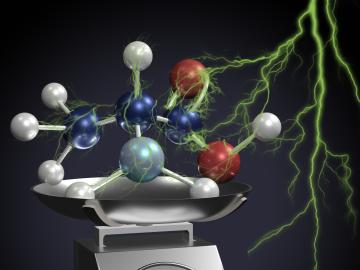
Filter News
Area of Research
- (-) Materials (75)
- (-) National Security (44)
- Advanced Manufacturing (3)
- Biology and Environment (119)
- Biology and Soft Matter (1)
- Computational Biology (1)
- Computational Engineering (2)
- Computer Science (11)
- Electricity and Smart Grid (3)
- Energy Science (170)
- Functional Materials for Energy (1)
- Fusion and Fission (9)
- Isotope Development and Production (1)
- Isotopes (27)
- Materials for Computing (14)
- Mathematics (1)
- Neutron Science (34)
- Nuclear Science and Technology (11)
- Quantum information Science (4)
- Sensors and Controls (1)
- Supercomputing (87)
- Transportation Systems (2)
News Topics
- (-) Artificial Intelligence (21)
- (-) Coronavirus (6)
- (-) Cybersecurity (21)
- (-) Environment (20)
- (-) Grid (11)
- (-) Isotopes (13)
- (-) Machine Learning (16)
- (-) Microscopy (27)
- (-) Space Exploration (2)
- (-) Transportation (16)
- 3-D Printing/Advanced Manufacturing (25)
- Advanced Reactors (5)
- Big Data (7)
- Bioenergy (14)
- Biology (8)
- Biomedical (8)
- Biotechnology (1)
- Buildings (6)
- Chemical Sciences (32)
- Clean Water (3)
- Composites (9)
- Computer Science (33)
- Critical Materials (13)
- Energy Storage (35)
- Exascale Computing (2)
- Frontier (3)
- Fusion (8)
- High-Performance Computing (8)
- Irradiation (1)
- ITER (1)
- Materials (74)
- Materials Science (78)
- Mathematics (1)
- Molten Salt (3)
- Nanotechnology (39)
- National Security (35)
- Neutron Science (35)
- Nuclear Energy (21)
- Partnerships (15)
- Physics (28)
- Polymers (17)
- Quantum Computing (3)
- Quantum Science (12)
- Security (11)
- Simulation (2)
- Summit (4)
Media Contacts
Scientists at the Department of Energy’s Oak Ridge National Laboratory (ORNL) have developed a process that could remove CO2 from coal-burning power plant emissions in a way that is similar to how soda lime works in scuba diving rebreathers. Their research, published January 31 in...

OAK RIDGE, Tenn., Jan. 31, 2019—A new electron microscopy technique that detects the subtle changes in the weight of proteins at the nanoscale—while keeping the sample intact—could open a new pathway for deeper, more comprehensive studies of the basic building blocks of life.

Oak Ridge National Laboratory scientists studying fuel cells as a potential alternative to internal combustion engines used sophisticated electron microscopy to investigate the benefits of replacing high-cost platinum with a lower cost, carbon-nitrogen-manganese-based catalyst.

Thought leaders from across the maritime community came together at Oak Ridge National Laboratory to explore the emerging new energy landscape for the maritime transportation system during the Ninth Annual Maritime Risk Symposium.

Carbon fiber composites—lightweight and strong—are great structural materials for automobiles, aircraft and other transportation vehicles. They consist of a polymer matrix, such as epoxy, into which reinforcing carbon fibers have been embedded. Because of differences in the mecha...
Physicists turned to the “doubly magic” tin isotope Sn-132, colliding it with a target at Oak Ridge National Laboratory to assess its properties as it lost a neutron to become Sn-131.

Scientists at the Department of Energy’s Oak Ridge National Laboratory used neutrons, isotopes and simulations to “see” the atomic structure of a saturated solution and found evidence supporting one of two competing hypotheses about how ions come

An Oak Ridge National Laboratory-led team used a scanning transmission electron microscope to selectively position single atoms below a crystal’s surface for the first time.

Sergei Kalinin of the Department of Energy’s Oak Ridge National Laboratory knows that seeing something is not the same as understanding it. As director of ORNL’s Institute for Functional Imaging of Materials, he convenes experts in microscopy and computing to gain scientific insigh...

A new microscopy technique developed at the University of Illinois at Chicago allows researchers to visualize liquids at the nanoscale level — about 10 times more resolution than with traditional transmission electron microscopy — for the first time. By trapping minute amounts of...


